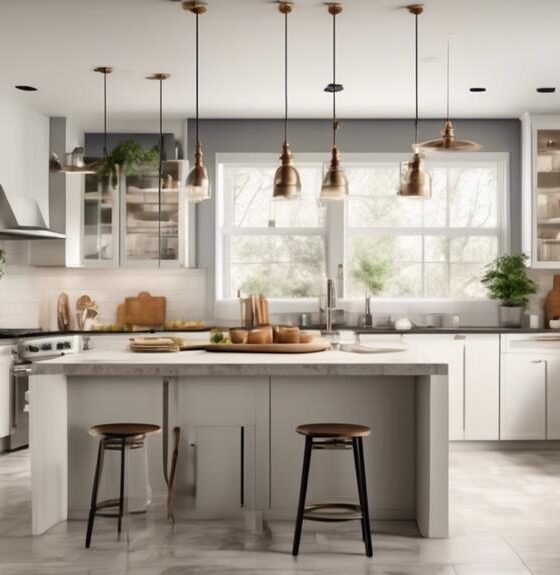Beginners Guides
Painting Window Glass Black

Here at our humble abode, we've been pondering the prospect of painting window glass black. The idea of transforming the transparency of our windows into a sleek, sophisticated style has been a tantalizing thought.
However, the process of achieving this desired look can be quite intricate. It involves selecting the appropriate paint, preparing the glass surface with precision, and ensuring that the final result is not only visually striking but also durable.
So, how does one go about mastering this meticulous art of painting window glass black?
Key Takeaways
- High-quality, durable, and weather-resistant paint is crucial for painting window glass black.
- Thoroughly clean the glass surface and use a surface primer specifically formulated for glass.
- Apply the paint with precision and allow each layer to dry thoroughly.
- Monitor the drying process and consider environmental factors like humidity.
Choosing the Right Paint
When selecting the paint for painting window glass black, it's crucial to choose a high-quality, durable, and weather-resistant option. The key factors to consider are paint adhesion and surface primer. We want to ensure that the paint adheres well to the glass surface and that it has a proper surface primer to promote adhesion.
A high-quality paint specifically designed for glass surfaces is essential to achieve a long-lasting and professional-looking finish.
To achieve optimal paint adhesion, it's recommended to thoroughly clean the glass surface and remove any dirt, dust, or residue. This will ensure that the paint has a clean and smooth surface to adhere to, preventing any potential peeling or flaking in the future.
Additionally, using a surface primer specifically formulated for glass will further enhance the adhesion of the paint, creating a strong bond between the glass and the paint.
Preparing the Glass Surface
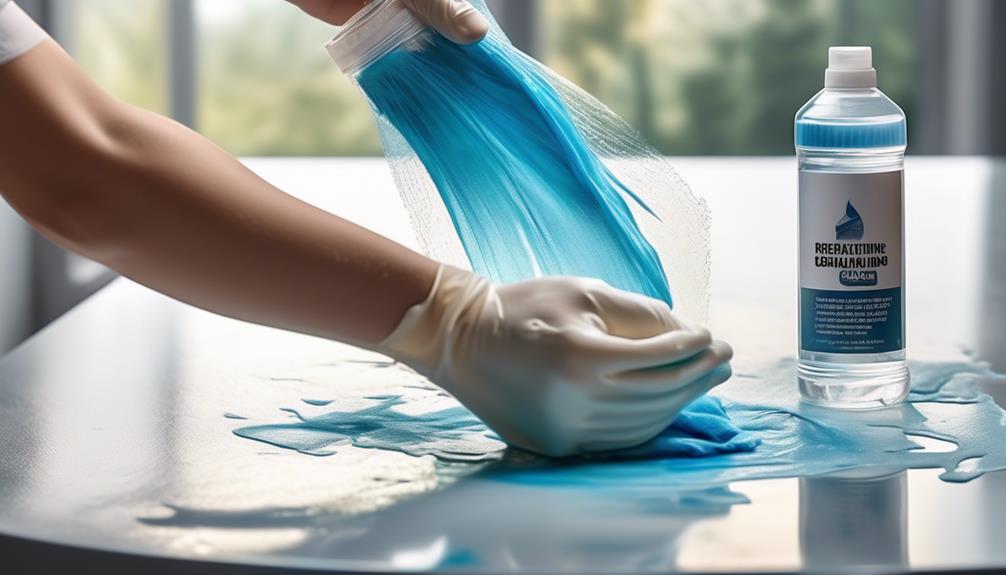
First, thoroughly clean the glass surface to remove any dirt, dust, or residue before proceeding with the preparation. This step is crucial to ensure proper adhesion of the primer and paint. Use a glass cleaner or a solution of water and vinegar to clean the surface, and then dry it thoroughly with a lint-free cloth to avoid leaving any streaks or residue.
| Surface Cleaning | Primer Application |
|---|---|
| Use glass cleaner or a solution of water and vinegar to clean the glass surface thoroughly. | Apply a thin, even coat of glass primer to the cleaned surface. |
| Dry the glass surface completely with a lint-free cloth to avoid leaving any streaks or residue. | Allow the primer to dry according to the manufacturer's instructions before applying the paint. |
| Inspect the glass to ensure it is free from any remaining dirt, dust, or residue. | Once the primer is dry, the glass surface is ready for the application of the black paint. |
| If needed, repeat the cleaning process until the surface is completely clean. | |
After the glass surface is cleaned, the next step is the application of the primer. Proper surface cleaning and primer application are essential for achieving a professional and long-lasting black finish on the window glass.
Applying the Paint
After ensuring the primer has dried completely, we can proceed with applying the black paint to the window glass surface. To achieve a professional finish, it's crucial to pay attention to the paint adhesion and use a layering technique that ensures even coverage and durability.
- Precision: When applying the paint, ensure that each stroke is deliberate and even. This precision will result in a smooth and flawless finish.
- Patience: Allow each layer of paint to dry thoroughly before applying the next one. Rushing this process can lead to uneven coverage and potential paint adhesion issues.
- Consistency: Maintain a consistent pressure and speed while applying the paint to ensure an even layer across the entire surface.
When it comes to paint adhesion, the key lies in proper preparation and application. Ensuring that the glass surface is clean and free of any contaminants will promote better adhesion. Additionally, utilizing a layering technique won't only enhance the depth of the black paint but also contribute to its longevity.
Ensuring Proper Drying

To ensure proper drying, we should carefully monitor the painted window glass for any signs of tackiness or moisture. Proper drying time is essential to achieve a smooth and streak-free finish. Factors such as humidity can affect the drying time, so it's crucial to consider the environment before starting the painting process.
| Drying Time | Humidity Level |
|---|---|
| 1-2 hours | Below 50% |
| 3-4 hours | 50-70% |
| 5-6 hours | Above 70% |
The table above provides a general guideline for drying time based on humidity levels. However, it's important to note that these times can vary based on the type of paint and the specific environmental conditions.
When it comes to avoiding streaks, the brush technique plays a significant role in achieving a smooth and even coat. To prevent streaks, use long, smooth strokes and avoid overworking the paint. Additionally, make sure to paint in the same direction for each coat to maintain consistency.
Maintaining and Cleaning the Painted Glass
Monitoring the painted window glass for any signs of tackiness or moisture is crucial as we shift our focus to maintaining and cleaning the painted glass. Regularly inspecting the glass surface ensures that any issues are promptly addressed, preventing potential damage to the paint and underlying glass.
When it comes to maintaining and cleaning painted glass, the following key points should be considered:
- Gentle Cleaning Techniques: Utilize soft, non-abrasive cloths and mild, non-ammonia based cleaners to ensure that the painted surface isn't compromised during cleaning.
- Regular Inspection and Touch-ups: Periodically inspect the painted glass for any signs of wear and tear, and touch up any areas where the paint may have chipped or faded to maintain the overall appearance and longevity of the paint.
- Protective Coating Application: Consider applying a protective coating designed for painted glass surfaces to enhance long term durability and ease of cleaning.
Adhering to these maintenance practices will help preserve the integrity of the painted glass, ensuring its long term durability and keeping it looking its best for years to come.
Frequently Asked Questions
Is It Possible to Remove the Black Paint From the Glass if I Change My Mind in the Future?
Yes, it's possible to remove the black paint from the glass if we change our mind in the future. However, the long-term durability of the paint and the impact of weather conditions on its removal should be considered.
It's important to use high-quality paint and proper sealing techniques to ensure easier removal in the future. Regular maintenance and care will also contribute to the ease of removing the paint when needed.
Will Painting the Glass Black Affect the Amount of Light That Comes Through the Window?
Painting window glass black can significantly reduce the amount of natural light that enters the room. This can impact the overall aesthetic of the interior design, creating a more dramatic and moody atmosphere.
However, it's important to consider the potential effects on the functionality of the space and the need for natural light. It's a delicate balance between design and practicality when making decisions about altering natural lighting in a room.
Can I Still See Through the Glass After It Has Been Painted Black?
Yes, painting glass black will significantly reduce its transparency. This can impact the visual appeal and decorative applications of the glass.
However, it can also provide privacy, making it suitable for certain settings. Keep in mind that the level of transparency will depend on the type of paint and the number of coats applied.
It's important to consider the intended purpose and aesthetic when deciding to paint glass black.
Will the Black Paint Hold up in Extreme Weather Conditions, Such as Intense Sunlight or Heavy Rain?
In the world of paint durability, weather conditions play a critical role in determining long-term effects. When it comes to black paint, intense sunlight and heavy rain can test its resilience.
However, with the right preparation and application, black paint can hold up well in extreme weather conditions. Proper priming and sealing can help maximize the longevity of the black paint, ensuring it withstands the elements for years to come.
Are There Any Safety Precautions I Should Take When Painting Glass Black, Such as Ventilation or Protective Gear?
When painting glass, it's crucial to prioritize safety. Ventilation is key to avoid inhaling fumes, and protective gear like gloves and goggles shield against potential splatters.
Additionally, considering visual aesthetics and privacy concerns can guide our decision-making process. By taking these precautions, we can ensure a successful and safe painting experience.
Should I Paint My Window Glass Black to Block Light From the Top of Curtains?
If you’re looking to prevent light from seeping in through the top of your curtains, painting your window glass black might not be the best solution. Consider using blackout curtains or installing a blackout liner to achieve a more effective way of blocking light from the curtains’ top.
Conclusion
As we watch the black paint dry on the window glass, we can't help but see it as a reflection of our own inner struggles and fears. Just as the paint transforms the glass, we too can transform our own obstacles into opportunities.
With patience and care, we can create something beautiful out of darkness. So let's embrace the process and remember that even the darkest moments can lead to something truly remarkable.
- About the Author
- Latest Posts
Introducing Ron, the home decor aficionado at ByRetreat, whose passion for creating beautiful and inviting spaces is at the heart of his work. With his deep knowledge of home decor and his innate sense of style, Ron brings a wealth of expertise and a keen eye for detail to the ByRetreat team.
Ron’s love for home decor goes beyond aesthetics; he understands that our surroundings play a significant role in our overall well-being and productivity. With this in mind, Ron is dedicated to transforming remote workspaces into havens of comfort, functionality, and beauty.
Beginners Guides
Cinnamon Waffle Mix

Cinnamon waffle mix has the potential to revolutionize breakfast for those who may not have considered it before. The delicate balance of warmth and sweetness from cinnamon paired with the crunch of perfectly cooked waffles makes for a delectable morning indulgence.
But there's more to this mix than just a delicious flavor. As we explore the world of cinnamon waffle mix, we'll uncover surprising health benefits, tips for customization, and inventive serving suggestions that will elevate your breakfast game to a whole new level.
Stay tuned to discover the secrets of making the perfect cinnamon waffles.
Key Takeaways
- Cinnamon waffle mix emerged in the early 20th century to meet the demand for diverse waffle flavors and gained popularity due to its ability to blend well with sweet and savory toppings.
- Key ingredients for perfect cinnamon waffles include cinnamon for its warm and aromatic flavor and health benefits, the type of flour used significantly impacts the texture and nutritional value, the choice of sweeteners influences the flavor profile, and selecting high-quality and fresh cinnamon is crucial.
- Tips for customizing cinnamon waffles include experimenting with mix-ins like chopped nuts, dried fruits, or chocolate chips, drizzling warm caramel or chocolate sauce for a more indulgent option, incorporating fresh fruits for a refreshing contrast, and adding crispy bacon crumbles or shredded cheese for a savory twist.
- Cinnamon in waffle mix adds antioxidants and anti-inflammatory properties, enhancing its nutritional profile and promoting overall health and well-being. Serving suggestions include topping with fresh fruits, adding whipped cream or maple syrup, and garnishing with chopped nuts for visual appeal.
The Origin of Cinnamon Waffle Mix

Studying the history of commercial waffle mixes reveals the intriguing evolution of flavors and ingredients, including the emergence of the popular Cinnamon Waffle Mix. The origin of Cinnamon Waffle Mix can be traced back to the early 20th century when the demand for diverse waffle flavors started to gain popularity. The introduction of cinnamon to waffle batter was a game-changer, as it added a warm, aromatic twist to the traditional waffle, delighting taste buds and capturing the attention of consumers.
The cultural significance of the Cinnamon Waffle Mix lies in its ability to blend well with both sweet and savory toppings, making it a versatile choice for breakfast or brunch. Its popularity soared as it offered a unique and delightful flavor that appealed to a wide audience. The combination of the comforting aroma of cinnamon and the crisp texture of waffles created a harmonious culinary experience.
Furthermore, the Cinnamon Waffle Mix paved the way for innovative flavor combinations in the waffle industry, inspiring the creation of various other flavored waffle mixes.
Key Ingredients for Perfect Cinnamon Waffles
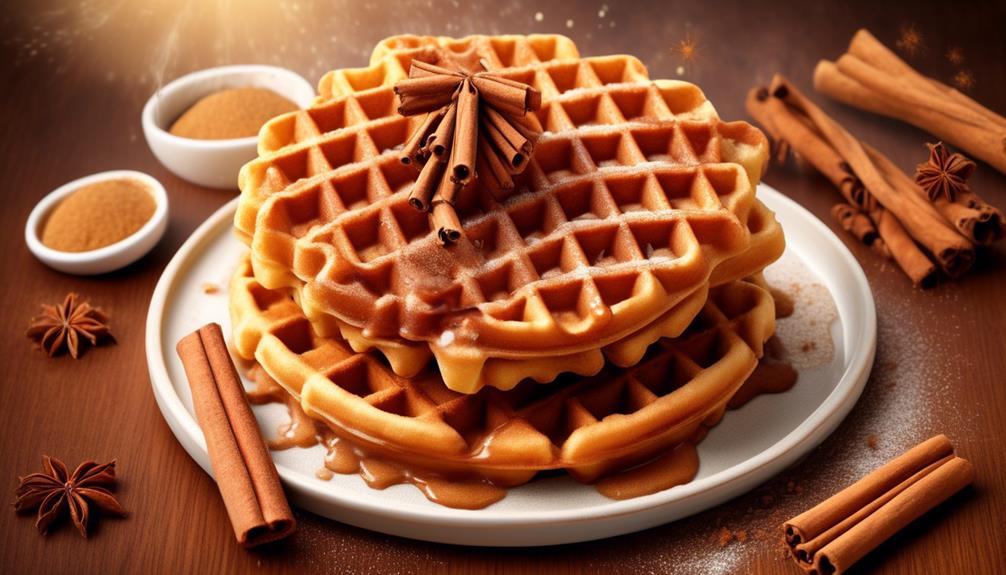
When aiming to create perfect Cinnamon Waffles, it's essential to carefully select and combine the key ingredients to achieve the desired flavor and texture. Cinnamon, a key ingredient in this recipe, not only adds a warm and aromatic flavor but also offers various health benefits. Studies have shown that cinnamon has antioxidant and anti-inflammatory properties, making it a valuable addition to the waffle mix. When incorporating cinnamon, it's crucial to ensure the freshness and quality of the spice to fully reap its benefits.
In addition to cinnamon, the selection of waffle variations is equally important in creating the perfect Cinnamon Waffles. The type of flour used, whether it's all-purpose, whole wheat, or a gluten-free alternative, can significantly impact the texture and overall nutritional value of the waffles. Furthermore, the choice of sweeteners, such as honey, maple syrup, or sugar, can also influence the flavor profile of the waffles. Carefully considering these key ingredients and variations is vital in achieving the perfect balance of flavor, texture, and nutritional benefits in Cinnamon Waffles.
Tips for Customizing Your Cinnamon Waffles
To enhance the flavor and texture of your Cinnamon Waffles, consider experimenting with various mix-ins and toppings to create a personalized and delectable breakfast treat.
When customizing your Cinnamon Waffles, exploring different flavor combinations can elevate your breakfast experience. Incorporating ingredients such as chopped nuts, dried fruits, or chocolate chips into the waffle batter can add delightful bursts of flavor and texture.
For those seeking a more indulgent option, consider drizzling warm caramel or chocolate sauce over the waffles, or topping them with a dollop of flavored whipped cream.
Additionally, incorporating fresh fruit such as berries, sliced bananas, or caramelized apples can provide a refreshing contrast to the warm, spiced waffles.
For a savory twist, try adding crispy bacon crumbles or shredded cheese into the waffle batter for a unique flavor profile.
Health Benefits of Cinnamon in Waffle Mix
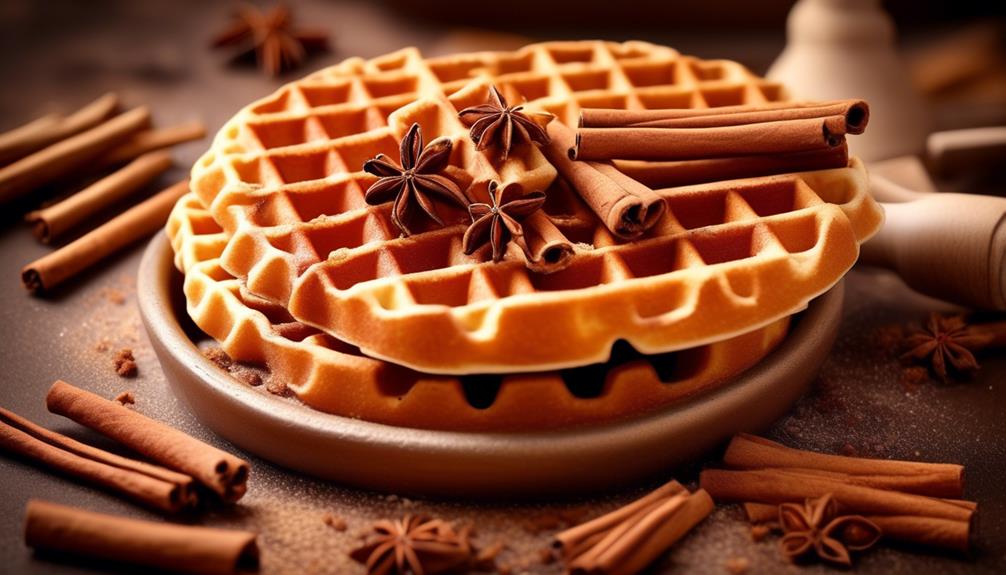
Incorporating cinnamon into waffle mix enhances its nutritional profile by infusing it with antioxidants and anti-inflammatory properties, contributing to a healthier breakfast option. Cinnamon has a rich history dating back to ancient times, where it was highly prized for its medicinal properties. Its culinary uses are diverse, spanning from sweet to savory dishes, making it a versatile ingredient.
When added to waffle mix, cinnamon not only imparts a warm and comforting flavor but also delivers a range of health benefits. The spice is packed with polyphenols, which are powerful antioxidants that help protect the body from oxidative damage caused by free radicals. Additionally, cinnamon contains compounds with anti-inflammatory properties, which are beneficial for overall health and well-being.
These properties make cinnamon an excellent addition to waffle mix, elevating its nutritional value without compromising on taste. By understanding the historical significance and culinary versatility of cinnamon, we can fully appreciate the health benefits it brings to our waffle mix, creating a delightful and nourishing breakfast option.
Serving Suggestions for Cinnamon Waffles
Having established the health benefits of cinnamon in waffle mix, we can now explore optimal serving suggestions to complement the warm and comforting flavors of cinnamon waffles. When it comes to serving cinnamon waffles, the right toppings and presentation styles can elevate the overall dining experience.
Consider the following serving suggestions:
- Topping Ideas
- Fresh Fruits: Sliced bananas, strawberries, or blueberries add a delightful burst of freshness and a pop of color to the warm waffles.
- Whipped Cream: A dollop of whipped cream enhances the indulgent nature of cinnamon waffles, providing a creamy and airy texture.
- Maple Syrup: The classic pairing of cinnamon and maple syrup enhances the sweetness and adds a rich, aromatic flavor to the waffles.
- Presentation Styles
- Stacked Tower: Create a visually appealing presentation by stacking the waffles in layers and drizzling the toppings in an artful manner.
- Artistic Drizzling: Use a squeeze bottle to artistically drizzle the toppings over the waffles, adding an elegant touch to the presentation.
- Garnish with Nuts: Sprinkling chopped nuts such as pecans or almonds on top of the waffles not only adds a delightful crunch but also enhances the visual appeal.
For an enhanced culinary experience, consider pairing cinnamon waffles with flavor combinations such as caramelized apples and cinnamon whipped cream or a side of vanilla bean ice cream for a delightful contrast of temperatures and textures.
Frequently Asked Questions
Can Cinnamon Waffle Mix Be Used to Make Pancakes or Other Baked Goods?
Yes, cinnamon waffle mix can be used to make pancakes or other baked goods.
When making pancakes, simply adjust the liquid-to-mix ratio as needed to achieve the desired consistency.
For other baked goods, the mix can be used as a base for various flavor variations and cooking techniques, such as incorporating it into muffin or cake recipes.
Experiment with different ingredients and cooking methods to create unique and flavorful treats.
Are There Any Allergens in the Cinnamon Waffle Mix?
We always scrutinize allergen information when trying new products. It's crucial for anyone with dietary restrictions. When exploring dietary alternatives, understanding allergen content is paramount.
In this case, we'd meticulously examine the allergen information for the cinnamon waffle mix. This practice ensures that we make informed choices and stay mindful of potential allergens.
Can the Cinnamon Waffle Mix Be Made Without Eggs or Dairy for Those With Dietary Restrictions?
We can make the cinnamon waffle mix without eggs or dairy by using vegan alternatives and substitutions. This modification caters to those with dietary restrictions.
Additionally, the vegan version may offer health benefits and nutritional value, such as lower cholesterol and saturated fat content.
When carefully selecting plant-based ingredients, we can create a delicious and satisfying waffle mix that aligns with various dietary preferences and requirements.
How Long Does the Cinnamon Waffle Mix Stay Fresh After Opening?
After opening, the cinnamon waffle mix stays fresh for about 3-6 months when stored in an airtight container in a cool, dry place.
For longer shelf life, consider freezing the mix.
When it comes to recipe variations, try adding diced apples or pecans for a delightful twist.
Experiment with flavor options by incorporating vanilla extract or a hint of nutmeg for an extra kick.
Can the Cinnamon Waffle Mix Be Used in a Waffle Maker or Can It Be Cooked on a Stovetop?
We recommend using the cinnamon waffle mix in a waffle maker for best results. This cooking option provides even heat distribution and allows the waffles to cook evenly and achieve the desired texture.
However, the mix can also be cooked on a stovetop if a waffle maker isn't available, showcasing its versatility. These cooking options highlight the mix's adaptability and make it suitable for various kitchen setups.
Can I Use a Modern Mixer to Make Cinnamon Waffles?
Yes, you can use a modern mixer to make cinnamon waffles. With innovative kitchen appliance technology, the mixer can easily blend the batter to the perfect consistency, making it quick and convenient to whip up a delicious breakfast treat.
Conclusion
In conclusion, cinnamon waffle mix is a delightful addition to any breakfast menu. The combination of warm, comforting cinnamon and crispy waffles is a match made in heaven.
Whether you prefer a classic cinnamon waffle or want to get creative with toppings and mix-ins, this versatile mix is sure to please.
So go ahead, spice up your morning routine with a batch of scrumptious cinnamon waffles and start your day on a delicious note.
- About the Author
- Latest Posts
Introducing Ron, the home decor aficionado at ByRetreat, whose passion for creating beautiful and inviting spaces is at the heart of his work. With his deep knowledge of home decor and his innate sense of style, Ron brings a wealth of expertise and a keen eye for detail to the ByRetreat team.
Ron’s love for home decor goes beyond aesthetics; he understands that our surroundings play a significant role in our overall well-being and productivity. With this in mind, Ron is dedicated to transforming remote workspaces into havens of comfort, functionality, and beauty.
Beginners Guides
What Temp Do I Cook Pancakes on a Griddle
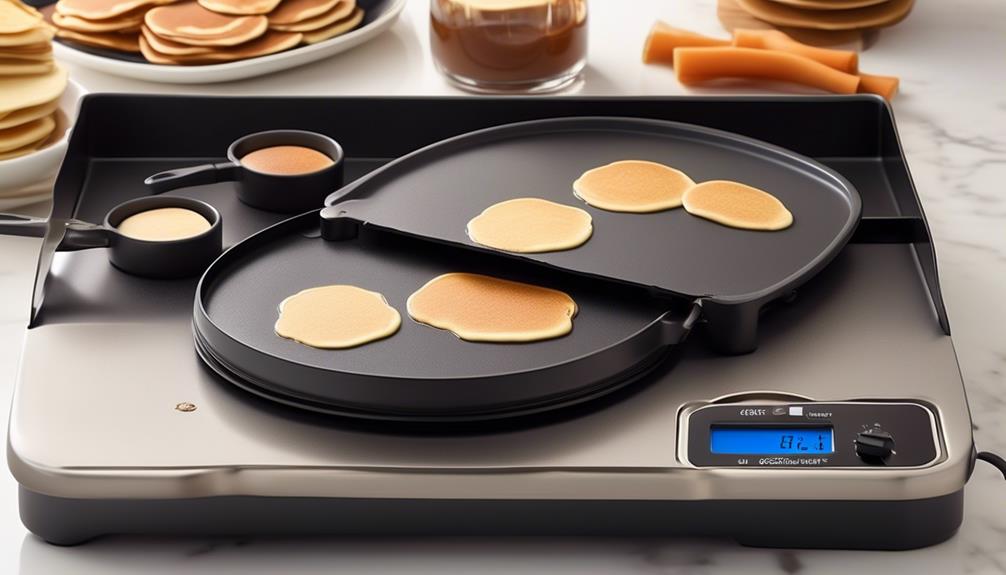
When it comes to making pancakes on a griddle, getting the temperature just right is crucial for achieving that ideal golden-brown color and fluffy texture. Let’s be honest, determining the perfect heat level can often seem like a game of trial and error.
We've all been there, standing in front of the griddle, wondering if it's too hot or not hot enough. Well, fear not, because in this discussion, we're going to unravel the mystery of what temperature you should cook your pancakes on a griddle.
So, if you've ever found yourself flipping pancakes that are either too pale or overly browned, stick around because we've got you covered.
Key Takeaways
- Heat distribution impacts texture and flavor
- Temperature control is crucial for consistent results
- Adjusting temperature is necessary for different pancake types
- Regularly clean griddle surface to maintain even heat distribution
Understanding the Importance of Temperature
Understanding the importance of temperature is crucial when cooking pancakes on a griddle as it directly impacts the texture and flavor of the final product. Heat distribution plays a key role in ensuring that the pancakes are evenly cooked. An ideal griddle should provide uniform heat distribution to prevent uneven cooking, which can result in pancakes that are overly browned in some areas and undercooked in others. Temperature control is another critical factor. Maintaining a consistent temperature throughout the cooking process is essential for achieving perfectly golden-brown pancakes with a fluffy interior.
Research indicates that a griddle with superior heat distribution capabilities and precise temperature control settings can significantly enhance the cooking experience. Advanced griddles often utilize innovative heating elements and engineering designs to ensure even heat distribution across the cooking surface. Additionally, temperature control features such as adjustable thermostats enable cooks to regulate the heat output, allowing for precise cooking temperatures to be maintained.
Finding the Right Griddle Temperature
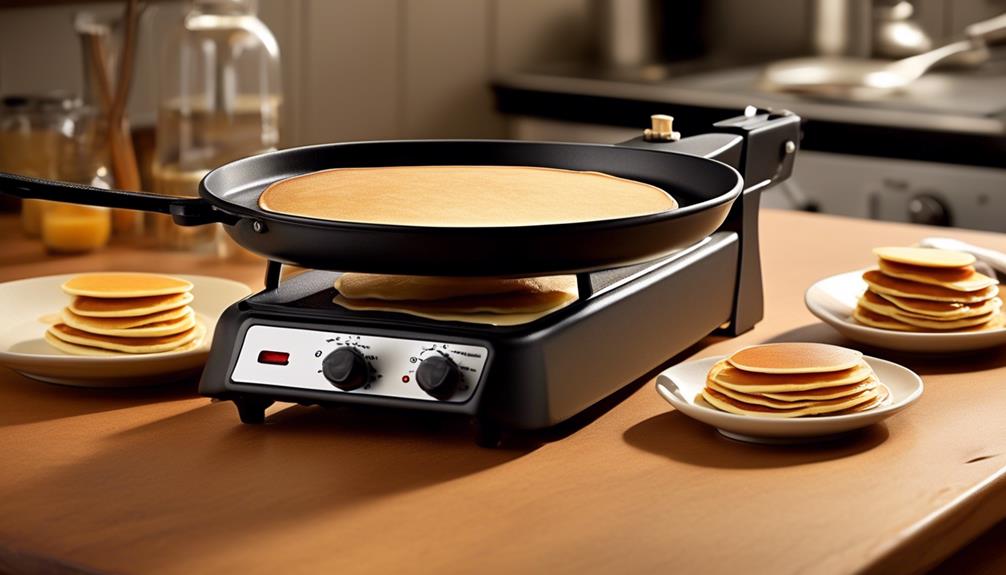
We consistently adjust the griddle temperature to achieve the perfect golden-brown pancakes with a fluffy interior. Finding the right griddle temperature is essential for ensuring even heat distribution and optimal cooking time.
- Preheat: Before pouring the pancake batter onto the griddle, preheat it to 375°F (190°C) to ensure that the pancakes cook evenly.
- Test the Heat: Use a few drops of water to test the griddle's temperature. If the water sizzles and evaporates almost instantly, the griddle is at the right temperature for cooking pancakes.
- Adjust as Needed: Throughout the cooking process, monitor the temperature and make adjustments as necessary to maintain a consistent heat level.
- Cooking Time: Once the pancakes are on the griddle, cook them for approximately 2-3 minutes on the first side, or until bubbles form on the surface. Then, flip and cook for an additional 1-2 minutes on the other side until both sides are golden brown.
Tips for Testing Heat Levels
To accurately gauge the griddle's heat level, a simple water droplet test can be employed before cooking the pancakes. This test not only helps in determining the heat consistency across the griddle but also assesses the heat distribution.
When conducting the water droplet test, it's crucial to ensure that the griddle has been preheated to the desired temperature. Once the griddle is adequately hot, sprinkle a few drops of water onto its surface.
If the water droplets sizzle and evaporate almost immediately, the griddle is likely too hot. Conversely, if the water droplets pool together and take a long time to evaporate, the griddle is probably not hot enough.
The ideal scenario is when the water droplets sizzle, dance, and evaporate quickly without leaving any residual water on the surface. This test is effective for testing consistency in heat across the griddle and can help identify any potential hotspots, allowing for adjustments to be made before cooking the pancakes, ensuring even cooking.
Adjusting Temperature for Different Pancake Types
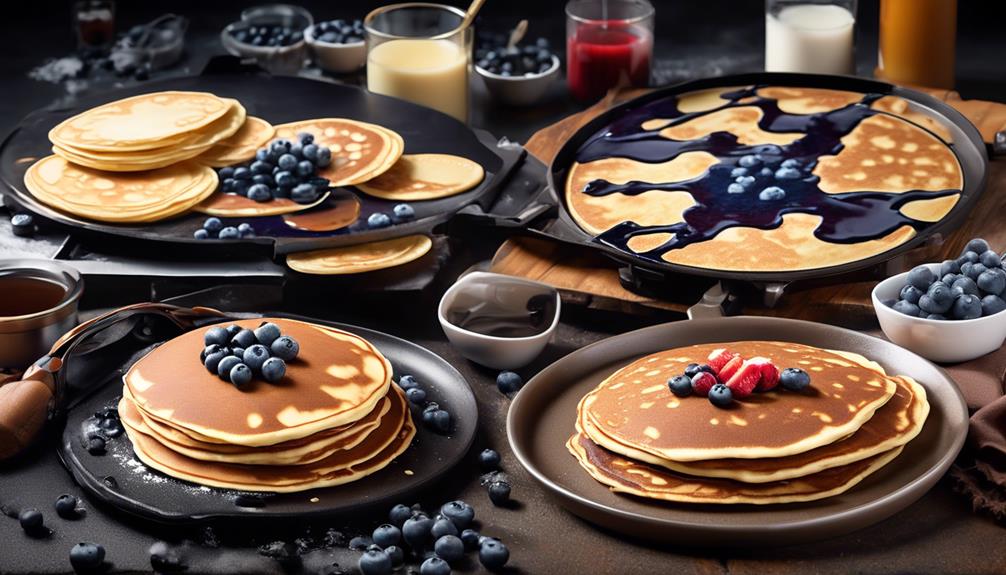
After assessing the heat levels on the griddle using the water droplet test, the next step is to adjust the temperature based on the type of pancake being cooked.
- Pancake consistency: For thicker pancakes, such as buttermilk or blueberry pancakes, lower the temperature slightly to ensure that the inside cooks through without burning the outside. Thinner pancakes, like crepes, require a slightly higher temperature to achieve the ideal consistency.
- Heat distribution: Pay attention to the griddle's heat distribution. If the center is hotter than the edges, consider lowering the temperature to prevent uneven cooking. Conversely, if the edges are cooler, a slightly higher temperature may be needed to ensure even doneness.
- Batter thickness: Thicker batters benefit from lower temperatures to allow for thorough cooking, while thinner batters may require a slightly higher heat to set properly.
- Add-ins: When incorporating ingredients such as chocolate chips or fruit into the batter, adjust the temperature to prevent the add-ins from burning while ensuring the pancake cooks evenly.
Troubleshooting Temperature Issues
If experiencing uneven cooking or inconsistent browning, carefully evaluate the griddle's temperature settings and heat distribution to identify and address any potential issues. Griddle maintenance plays a crucial role in ensuring consistent heat distribution. Over time, griddles can develop hot spots or uneven heating due to wear and tear. Regularly cleaning the griddle surface and checking for any signs of damage can help maintain even heat distribution. Additionally, it's essential to calibrate the temperature settings periodically to ensure accuracy.
Flipping techniques can also impact the overall cooking process. If pancakes are cooking unevenly, it may be beneficial to adjust the flipping technique. Ensure that the pancakes are fully set before flipping to prevent batter from spreading unevenly. Proper flipping can help achieve consistent browning on both sides.
Frequently Asked Questions
Can I Use a Griddle to Cook Pancakes on an Outdoor Grill?
Yes, we can use an outdoor griddle to cook pancakes on an outdoor grill. It's essential to ensure that the grill temperature is steady and around 350-375°F for optimal pancake cooking.
Preheat the griddle to this temperature and lightly oil it before pouring the pancake batter.
When bubbles form, and the edges set, it's time to flip the pancake.
This method allows for delicious pancakes with a slight hint of smokiness from the grill.
How Do I Know if My Griddle Is Compatible With Induction Cooktops?
When it comes to determining if my griddle is compatible with induction cooktops, we need to consider the material and heat distribution.
Induction cooktops require a ferromagnetic material to work, so I'd check if my griddle is made of materials like cast iron or magnetic stainless steel.
Additionally, I'd look for even heat distribution across the griddle surface, as this is crucial for controlling the temperature precisely on an induction cooktop.
What Is the Best Temperature for Cooking Gluten-Free Pancakes on a Griddle?
For gluten-free pancake recipes, achieving the perfect temperature on the griddle is crucial. Our research shows that setting the griddle to a medium heat, around 350°F, works well. This allows the pancakes to cook evenly without burning.
Using a non-stick cooking spray or a light layer of oil helps prevent sticking. Additionally, waiting until the surface is hot before pouring the batter ensures a golden brown result.
Can I Use a Cast Iron Griddle to Cook Pancakes on an Electric Stove?
Certainly, using a cast iron griddle on an electric stove is feasible.
To maintain your griddle, ensure it's seasoned properly to prevent sticking.
Opt for low to medium heat to avoid uneven cooking.
When flipping pancakes, use a thin spatula and wait for bubbles to form on the surface.
Mastering these techniques will yield consistently perfect pancakes, each time.
Are There Any Special Temperature Considerations for Cooking Pancakes on a Non-Stick Griddle?
When cooking pancakes on a non-stick griddle, it's important to consider the flipping technique and batter consistency.
The non-stick coating ensures easy flipping and prevents the pancakes from sticking. Heat distribution is also crucial for even cooking.
A moderate heat setting allows the pancakes to cook through without burning. Consistent temperature and proper flipping technique result in evenly cooked, golden brown pancakes.
Conclusion
In conclusion, finding the perfect temperature for cooking pancakes on a griddle is crucial for achieving golden, fluffy perfection. By testing the heat levels and adjusting for different pancake types, we can ensure that our pancakes turn out just right.
Remember, finding the right temperature is like finding the sweet spot in a game of darts – it may take a little practice, but the reward is oh so satisfying.
Happy pancake flipping!
- About the Author
- Latest Posts
Introducing Ron, the home decor aficionado at ByRetreat, whose passion for creating beautiful and inviting spaces is at the heart of his work. With his deep knowledge of home decor and his innate sense of style, Ron brings a wealth of expertise and a keen eye for detail to the ByRetreat team.
Ron’s love for home decor goes beyond aesthetics; he understands that our surroundings play a significant role in our overall well-being and productivity. With this in mind, Ron is dedicated to transforming remote workspaces into havens of comfort, functionality, and beauty.
Beginners Guides
Light Color Meaning

Understanding the significance of light colors is similar to unraveling the intricacies of a beautiful piece of artwork. The impact that light colors have on our perceptions, emotions, and behaviors is profound and goes beyond just aesthetics.
From the soothing embrace of warm tones to the invigorating energy of cool hues, the psychology of light colors offers a fascinating insight into the human experience. But what exactly is the connection between light colors and our mood? And how can we leverage this knowledge to create environments that are conducive to productivity, relaxation, and overall well-being?
Key Takeaways
- Light colors have a profound impact on human emotions and perceptions.
- Different hues evoke varying emotional responses.
- Understanding the psychology of light colors is crucial in fields like interior design and marketing.
- Different cultures attach specific meanings to light colors.
The Psychology of Light Colors
When considering the psychology of light colors, it's essential to recognize the profound impact they have on human emotions and perceptions. Color perception is a complex interplay between the physical properties of light and the human visual system. Light colors can evoke a wide range of emotions and psychological responses, influencing human perception in subtle yet significant ways.
The human brain processes light colors through a combination of biological, psychological, and cultural factors. Different hues can elicit varying emotional responses, such as calmness from cool tones like blue and green, or energy from warm tones like red and yellow. These responses aren't only subjective but also influenced by individual experiences and cultural backgrounds.
Moreover, light colors can also affect cognitive processes and behavior. For example, studies have shown that exposure to certain light colors can impact concentration, productivity, and even appetite. Understanding the psychology of light colors is crucial in various fields, including interior design, marketing, and environmental psychology, as it can be leveraged to create specific atmospheres and influence human behavior.
Therefore, grasping the intricate relationship between light colors and human perception is essential for anyone seeking to master the art of utilizing color to evoke specific emotional and perceptual responses.
Impact on Mood and Emotions

Considering the profound impact of light colors on human emotions and perceptions, it is crucial to explore their influence on mood and emotions. Color psychology delves into the physiological effects of different light colors on the human mind and body. Understanding how light colors impact emotions can provide valuable insights for creating environments that evoke specific feelings and moods.
| Light Color | Emotional Impact |
|---|---|
| Blue | Calmness, serenity |
| Yellow | Happiness, optimism |
| Green | Balance, harmony |
| Red | Energy, passion |
| Purple | Creativity, luxury |
The physiological effects of light colors on mood are well-documented. For example, the color blue has been shown to lower blood pressure and heart rate, creating a sense of calmness and serenity. On the other hand, red is known to increase heart rate and evoke feelings of energy and passion. These physiological responses to light colors directly influence our emotional state and can be utilized in various settings such as homes, offices, and healthcare facilities to promote specific moods and emotions. Understanding the impact of light colors on mood allows for intentional use of color in creating environments conducive to desired emotional states.
Cultural and Symbolic Associations
Cultural and symbolic associations profoundly shape the meanings and interpretations of light colors across different societies and traditions. Color symbolism varies widely around the world, and different cultures attach specific meanings to different colors.
For instance:
- In some Eastern cultures, the color red is associated with good luck, joy, and prosperity, while in Western cultures, it's often linked to passion, danger, or love.
- White holds cultural significance as a symbol of purity and peace in many Western cultures, but it can symbolize mourning and death in some Eastern cultures.
- The color yellow can represent happiness and positivity in certain cultures, while in others, it may be associated with cowardice or betrayal.
Understanding these cultural significances is crucial when considering the use of light colors in various contexts, such as art, design, branding, and communication. It highlights the importance of being mindful of cultural diversity and the varied interpretations of light colors.
Practical Applications in Design
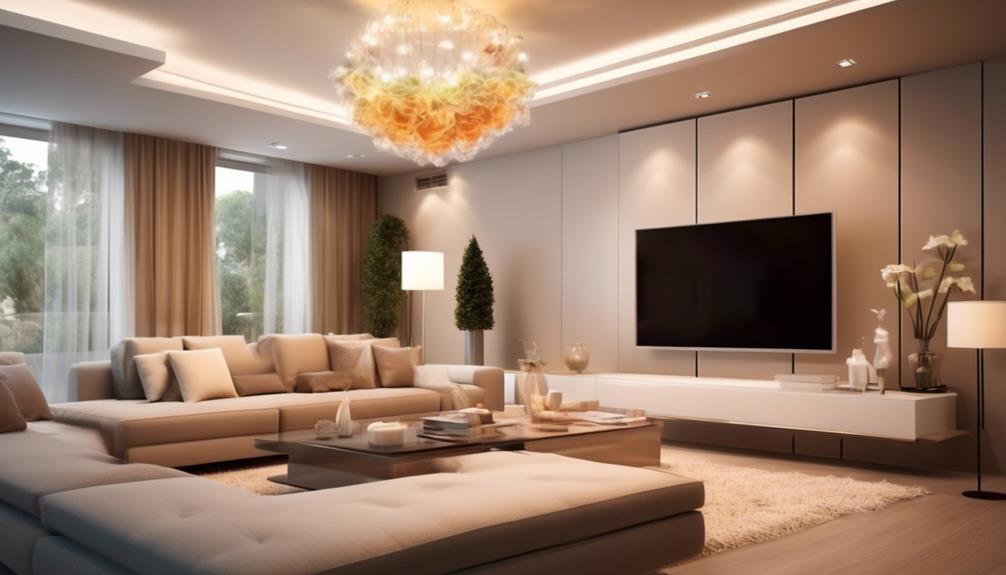
In practical design applications, understanding the cultural significance of light colors is essential for effectively conveying intended messages and resonating with diverse audiences. Utilizing color theory and understanding visual perception are critical components in creating impactful designs. By incorporating the psychological and emotional impact of different light colors, designers can evoke specific responses and create meaningful connections with their audience.
| Light Color | Practical Application |
|---|---|
| Warm Colors | Create a sense of energy and warmth, suitable for promoting products or services. |
| Cool Colors | Evoke calmness and tranquility, often used in healthcare or wellness-related designs. |
| Neutral Colors | Provide a versatile backdrop, suitable for professional and corporate settings. |
| Bright Colors | Grab attention and create a sense of excitement, ideal for marketing and advertising materials. |
Understanding the practical applications of light colors allows designers to strategically manipulate visual elements to achieve their desired outcomes. By leveraging the cultural and psychological associations of different light colors, designers can effectively communicate their message and establish a strong connection with their target audience. Incorporating color theory and visual perception into design practices empowers designers to create compelling visuals that resonate with viewers on a deep and meaningful level.
Choosing the Right Light Color
Drawing on our understanding of the practical applications of light colors in design, the process of choosing the right light color becomes a crucial decision-making factor in creating impactful visual experiences.
When considering the color temperature, it's essential to assess the visual comfort it provides. A warm color temperature, such as soft white or warm white, creates a cozy and inviting atmosphere, ideal for living spaces and restaurants. On the other hand, a cool color temperature, like daylight or cool white, fosters alertness and focus, making it suitable for offices and work environments.
Furthermore, color rendering plays a significant role in ambiance creation. High color rendering index (CRI) light sources accurately display the true colors of objects, enhancing the overall visual experience. This is particularly important in retail settings where accurate color perception influences purchasing decisions. In contrast, low CRI light sources may distort the appearance of colors, impacting the perceived quality of products and spaces.
Therefore, understanding color rendering is crucial when aiming to create specific moods and atmospheres in different environments.
Frequently Asked Questions
How Do Different Light Colors Affect Productivity and Focus in Work or Study Environments?
Different light colors can impact productivity and focus by affecting our circadian rhythms and mood. Color psychology suggests that certain hues can enhance productivity. For example, blue light may improve alertness and cognitive performance, while warm light can promote relaxation and calmness.
Understanding the effects of different light colors through light therapy can help optimize work or study environments for productivity enhancement.
Can the Use of Certain Light Colors in the Home Environment Impact Sleeping Patterns and Overall Quality of Sleep?
Absolutely! When it comes to relaxation, the impact of light color on our sleeping patterns is undeniable.
Bedroom lighting choices can make or break the quality of our sleep. The use of certain light colors in the home environment can have a profound effect on our ability to unwind and achieve restful sleep.
It's crucial to consider the influence of light color on our relaxation and overall sleep quality.
Are There Any Health Implications or Benefits Associated With Exposure to Specific Light Colors?
Exposure to specific light colors can have significant health benefits and psychological effects. Different wavelengths of light can impact our circadian rhythms, affecting sleep, mood, and overall well-being.
For example, blue light may disrupt sleep patterns, while warmer colors like red or amber may promote relaxation.
Understanding the effects of different light colors on our health can help us create environments that support our physical and mental wellness.
Do Different Light Colors Have an Impact on Visual Perception and the Ability to Distinguish Between Colors?
Different light colors can impact visual perception and the ability to distinguish between colors.
The lighting impact on visual perception can affect productivity and focus, especially in a study environment.
Understanding how different light colors influence our ability to perceive and distinguish between colors is crucial for creating optimal lighting conditions for tasks that require color accuracy, such as design and art.
Are There Any Religious or Spiritual Connotations Associated With Specific Light Colors That Are Not Covered in the Article?
There are various religious symbolism and cultural significance associated with specific light colors. Different cultures and spiritual traditions have unique interpretations and emotional associations with colors.
For example, in some belief systems, white symbolizes purity and peace, while red may signify passion or sacrifice. Understanding the spiritual interpretation of colors can provide insight into the deep connections between human emotions and cultural traditions.
Are the Meanings of Light Colors Different from Regular Color Meanings?
When understanding light color symbolism, it’s important to note that the meanings of light colors can vary from the regular color meanings. Light colors like pastel pink or soft yellow may convey a sense of delicacy and gentleness, while regular colors may have more intensity and impact on the viewer.
Conclusion
In conclusion, the use of light colors holds significant meaning and impact on our emotions and perceptions.
From the calming effect of cool blues to the energetic vibe of warm yellows, light colors play a vital role in our daily experiences.
They can symbolize purity, clarity, and hope, and can create a sense of serenity or excitement.
Understanding the psychology and cultural associations of light colors can help us make intentional choices in design and create powerful emotional connections.
- About the Author
- Latest Posts
Introducing Ron, the home decor aficionado at ByRetreat, whose passion for creating beautiful and inviting spaces is at the heart of his work. With his deep knowledge of home decor and his innate sense of style, Ron brings a wealth of expertise and a keen eye for detail to the ByRetreat team.
Ron’s love for home decor goes beyond aesthetics; he understands that our surroundings play a significant role in our overall well-being and productivity. With this in mind, Ron is dedicated to transforming remote workspaces into havens of comfort, functionality, and beauty.
-

 Vetted4 weeks ago
Vetted4 weeks ago15 Best Tile Sealers for Long-Lasting Protection and Shine
-

 Vetted4 weeks ago
Vetted4 weeks ago15 Best Printers of 2024: Top Picks and Expert Reviews
-

 Vetted1 week ago
Vetted1 week ago15 Best Leather Restorer Products to Revive Your Furniture and Accessories
-

 Vetted2 weeks ago
Vetted2 weeks ago15 Best Leg Massagers to Relieve Tension and Improve Circulation – Ultimate Guide
-

 Vetted3 weeks ago
Vetted3 weeks ago14 Best Lawn Tractors of 2024 – Ultimate Guide for Your Yard Maintenance
-

 Vetted4 days ago
Vetted4 days ago15 Best Contact Paper for Kitchen Cabinets to Elevate Your Home Decor
-

 Vetted3 days ago
Vetted3 days ago15 Best Drain Snakes to Unclog Your Pipes Like a Pro
-

 Vetted3 weeks ago
Vetted3 weeks ago15 Best Evergreen Plants for Shade Gardens: A Complete Guide
















